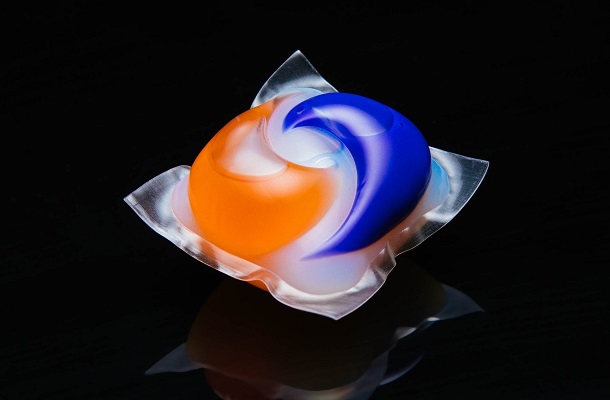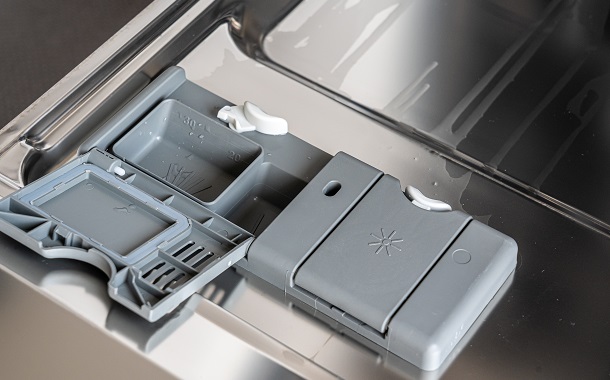We’ve all heard of needing to place a rinse aid into our dishwasher for the best cleaning results but nobody asks what a rinse aid does and is it needed for proper dishwasher functioning?
We will aim to answer that and what you can do to completely replace it if you don’t feel like using it.
IN THIS ARTICLE:
What Is Rinse Aid And What Does It Do?
Rinse aid comes in many forms but what it essentially does is reduce the surface tension of water. In simple terms, the water will sit flatter on your dishes resulting in fewer spots or none at all after the dishes dry. It’s commonly placed in the rinse aid dispenser and gets automatically released during the final rinse cycle of the dishwasher cycle.
Chemical Rinse Aid
All-In-One Tablets – If you have all-in-one tablets, likely, you don’t need to buy separate rinse aid. For an extra kick, you certainly can use it but it’s redundant.


Rinse-Aid Detergent – Bought as a liquid and gets placed in the rinse aid dispenser. Prices can vary but range anywhere from 10 dollars to 30 dollars.
How Often Do You Need To Refill It?
If you’re using your dishwasher often, meaning at least once every day, you’re likely to need to refill the dispenser every month. The amount varies from dishwasher to dishwasher but there’s a max line on the dispenser so you’ll simply fill it. No less, and no more.


Should I Be Using Rinse Aid?
It all depends on your preferences. We’ll let you decide but note that rinse aid stays on your dishes to have a full effect. The amount is relatively small but you don’t want you or your family to consume the chemicals found in it.
Toxic Chemicals Found In Rinse Aid
- Zinc Chloride – a type of salt
- Benzenesulfonic Acid
- Isotridecyl Alcohol
- Tetrasodium EDTA
- Sodium silicate
- Sodium Hydroxide – highly corrosive salt
- Sodium Cumenesulphonate – a salt
Among other issues, all of these cause respiratory irritation, nausea, vomiting, skin irritation, and burns to the eyes and skin
Note: A lot of what rinse aid is is different kinds of salts and you can use dishwasher salt as a rinse aid replacement


No Rinse Aid Wash: What Will Happen?
Nothing. Your dishes might come out being spotty but that’s about it. Dishwasher manufacturers, however, do recommend using a rinse aid for optimal dishwasher performance.
Popular Rinse Aid Brands
The most popular brands of rinse aid include Cascade, Finish, and Miele. The average price is around 20 dollars. If you’re scared of the chemicals, you can opt for eco-friendly rinse aid. Some of the best brands include Ecover and Nature Clean. If you have a preferred brand of rinse aid you can check how dangerous it is and its ratings.
Rinse Aid Replacements And Other Uses
Dishwasher Salt As A Rinse Aid
If your dishwasher has a dishwasher salt dispenser on the bottom inside, you can use it as a rinse aid replacement. It helps soften hard water which would mean that there will be less mineral build-up on your dishwasher and, finally, dishes.
Natural Rinse Aid Replacements
For natural rinse aid, you can use vinegar, hydrogen peroxide (which sounds scary but is used for teeth whitening), lemon juice or wedges, and citric acid. Most of these can simply be put directly in the dishwasher while only a few can be put in the rinse aid compartment. They’re cheaper and healthier although they might not be as efficient.


Bonus Rinse Aid Uses
Windows Cleaning: Simply add it to your window cleaning solution and it’ll leave your windows with fewer spots. The recommended are 2 gallons of water, 2 tbsp dawn, and 1 tbsp rinse aid.
No Streak Shower Doors: place 1 cup vinegar and two teaspoons rinse aid with water in a spray bottle and spray on glass shower doors. Spray after every shower for fewer spots.
Shiny Car Windows: Method is the same as with windows. You can even spray it on your whole car before a final wash so that it dries squeaky clean.
To Wrap It Up
If your dishes have a lot of stains on them after every wash, especially glasses, you might want to opt for using a rinse aid. Don’t worry, you don’t always have to buy rinse aid from the store as there are natural alternatives and dishwasher salt as well. Whatever you do, make sure you’re aware of the risks and weigh down the pros and cons.



















Leave a Reply